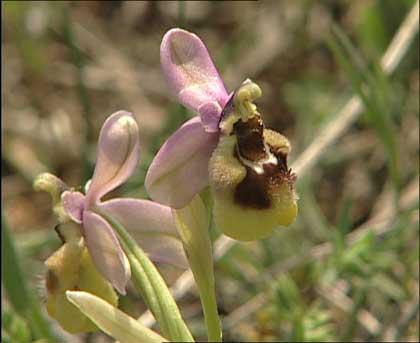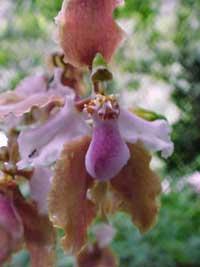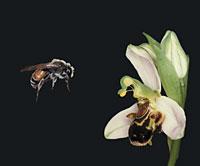Dazzling orchids
2002/02/17 Mendiburu, Joana - Elhuyar Zientziaren Komunikazioa
Orchids are an old and extensive family. Flowers of three petals. At the moment about 40,000 species have been identified, although it is estimated that there are still thousands of species to be discovered. As if that were not enough, the human being, mixing species, has created another 100,000 hybrids in laboratories.
It is such an extensive family of all sizes and colors. From microscopic measurements to lots of flowers the size of the football. And let's not say in the colors, all exotic, but similar none. The genus Dracula, for example, is dark red, but most have several colors: dark green with garnet, ivory with intense pink, yellow petals with purple tip... all combinations, both symmetrical and fully mixed. It is still a literary orchid only: the black orchid.
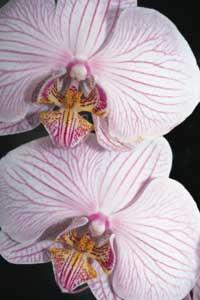
With both size and color not expected less than shapes. "The various forms of these plants cause fascination. They resemble birds, lizards, insects, women, men, etc. Sometimes they seem like a fervent fighter and sometimes a clown that causes laughter," said botanist Jakob Breyne in 1678.
Mixed fruit of the type of reproduction
The reason orchids have such different shapes, colors and sizes is their reproduction form. Most orchid species do not self-pollinate and thus the genetic material is mixed. Charles Darwin assured that complex plants in the struggle for survival survive better than those of simple pollination by mixing genetic information, as they are more likely to adapt to new situations.
Wind, birds, butterflies or bees are used to transport pollen from one plant to another. Therefore, plants should have the right shape to store pollen in a place that can be dragged by the wind or be attractive to insects.
Most orchids do not self-pollinate, even when their pollen is artificially applied. Moreover, for some species their pollen can be poison when they reach the gardener. Without insect attraction power orchids would disappear, but due to more than one attraction trick has not occurred.
Many orchids have managed to very much resemble their most beloved insect. The male insects, in the so-called female of their species, rest on the flower and get wet by pollen. When doing the same vacuum for the second time leave pollen of the first flower on the second. That is, the flower is wiser than the insect itself.
Other species of orchids are shaped like an insect prey. Botanists call this phenomenon pseudoanthogony. The insect, mixed, attacks the flower and in that useless struggle gets wet with pollen.
Other species have a label that closes when the bee approaches. His intention is to rub the bee with the pulley, not kill it. The bee, to escape from the back of the plant, is forced to go through scrambled threads soaked with pollen, thus achieving the flower its goal.
Other orchids secrete nectar or perfume that attracts small insects. Don't think perfume is always a pleasant smell! Some may smell rotten meat, but also chocolate, and even flowers appreciated by insects.
Attractive without measures
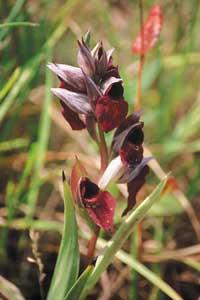
Orchids not only attract insects and birds, they have fascinated many people for their color, smell or other curiosities. But, according to an article published in 1906, the charm of orchids is based on reaching places where they grow. Orchids in lakes with common diseases, tropical forests, remote places where indigenous people live, etc. have therefore found a good function for adventurers.
The most prosperous years of orchid discovery Since the mid-twentieth century. They were until the beginning of the 20th century. At that time, what was presented for this work should be strong and courageous, as it had
gone on the adventure but there was no certainty of returning.
Currently the orchid trade moves $10 billion a year and a rare plant can cost $25,000. Thailand is the largest exporter of orchids. In addition to exporting plants, it earns an income of 30 million dollars with the flowers it sells to make lots of flowers and use them in dresses.
As expensive as buying orchids is to take care of them. There are caregivers specialized in orchids and orchid residences. To them the orchid that has not yet given the flower is carried and when the flower leaves the owner takes her home to show it. Some collectors have more than one floor in the residence and can pay $2,000 a month.
It is clear that to make the collection of orchids it is essential to be with money, and if they are known cases. Among other things, Charles Darrow, inventor of Monopoly, retired at age 46 to devote himself to the collection of orchids with the money he earned thanks to the game. The founder of Japan Airlines did the same. Michihiro Fukashima, tired of the business world, retired very young and, after leaving all his actions on behalf of his wife, abandoned all relationships and moved to Malaysia with his 2,000 orchestras.
Published in the supplement Estación de Gara.

Gai honi buruzko eduki gehiago
Elhuyarrek garatutako teknologia




